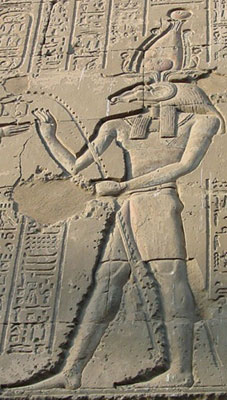

Khnum (Khnemu, Khenmu, Khenmew, Chnum) was one of the most ancient gods of Egypt, whose worship is thought to have been popular as early as the Predynastic Period. References from the Pyramid Texts of Unas confirm that his worship was long established even at that early stage and the Old Kingdom pharaoh Khufu (the builder of the Great Pyramid) was actually called “Khnum-Khufu” (“Khnum is his Protector”). However, it seems that the cult of Ra (or Re) rose to dominance at that time and Khnum was pushed to the sidelines as Khufu’s son and grandson (Khaf-Re and Menkau-Re) both took names honouring Ra.

Khnum was originally a water god who was thought to rule over all water, including the rivers and lakes of the underworld. He was associated with the source of the Nile, and ensured that the inundation deposited enough precious black silt onto the river banks to make them fertile. The silt also formed the clay, the raw material required to make pottery. As a result he was closely associated with the art of pottery. According to one creation myth, Khnum moulded everything on his potters wheel, including both the people and the other gods.
In Iunyt (Esna, in the 3rd Nome of Upper Egypt) it was proposed that Khnum also created the “First Egg” from which the sun was born (as Nefertum, Atum or Ra).
As well as creating the body and the “ka” (spirit) of each newborn child, he could bless the child. The Westcar Papyrus from the Second Intermediate Period includes the story of Khufu and the Magician in which the birth of three pharaohs is attended by Isis, Nephthys, Meskhenet, Heqet, and Khnum. After each child was born, Khnum gave them the gift of “health”. The pharaoh Hatshepsut also claimed that Khnum had formed her “ka” and given her the blessing of health at the request of her “father” Amun–Ra.

Khnum was also a protective deity of the dead. Spells invoking the assistance of Khnum can be found in the Book of the Dead and on many of the heart-scarabs interred with the dead because it was thought that he would help the deceased obtain a favourable judgement in the Halls of Ma’at.
The ram was considered to be a very potent animal, and so Khnum was associated with fertility. He makes an appearance on the “Famine Stele” found on Sehel island. The stele (which was allegedly inscribed during the reign of Djoser) tells that the pharaoh dreamed that the god would deliver the country from a terrible famine if a temple was built in his honour. The pharaoh immediately consecrated a temple to Khnum, and as promised the famine came to an end.
Khnum was one of the gods who was thought to have helped Ra on his perilous nocturnal journey through the underworld. It is also believed that he created the boat which carried Ra and helped defend the sun god against the serpent Apep (Apothis). Yet, he was sometimes considered to be the “ba” of Ra, because the word for “ram” in Egyptian was also “ba”. When Khnum was merged with Ra to form the composite deity Khnum-Ra this deity was associated with Nun (who represented the primeval waters), and given the epithet Hap-ur (“great Nile” or ” Nile of heaven”).

His cult was centered on the island of Abu (Elephantine 1st nome of Upper Egypt) where he had been worshiped since the Early Dynastic period . During the New Kingdom he was worshiped there as head of a triad with his wife Satet and his daughter Anuket. He was also worshipped at Esna (Iunyt) where he was thought to be married to both Menhet and Nebtu (a local goddess) and to be the father of Heka (god of magic known as “He Who Activates the Ka”).
He was also thought to be the husband of Neith at Esna. In Antinoe (Her-wer) he was married to Heqet, the frog goddess associated with childbirth and conception. He was associated with Her-shef at Herakleopolis Magna, and was often linked to Osiris. He was sometimes associated with Isis to represent the Upper Egypt, just as Ptah-Tanen was associated with Nepthys in representing Lower Egypt.
His name derives from the root khnem, “to join, to unite,” and with khnem, “to build”; astronomically the name refers to the “conjunction” of the sun and moon at stared seasons of the year, Khnum was the ‘Father of Fathers and the Mother of Mothers’ of the pharaoh. As a water god he was sometimes named “KebH”, meaning “purify”.
Khnum was depicted as either a ram, a man with the head of a ram, or a man with the horns of a ram. He was (very rarely) depicted with the head of a hawk, indicating his solar connections. He often wears the plumed white crown of Upper Egypt and was sometimes shown as holding a jar with water flowing out of it indicating his link with the source of the Nile. During the early period he was depicted as the early type of domesticated ram (with long corkscrew horns growing horizontally outwards from his head), but in later times was represented by the same type of ram as Amun (with horns curving inward towards him). Occasionally, he was depicted with four ram heads (representing sun god Ra, the air god Shu, the earth god Geb, and Osiris the god of the underworld ). In this form he was known as Sheft-hat.
Copyright J Hill 2010